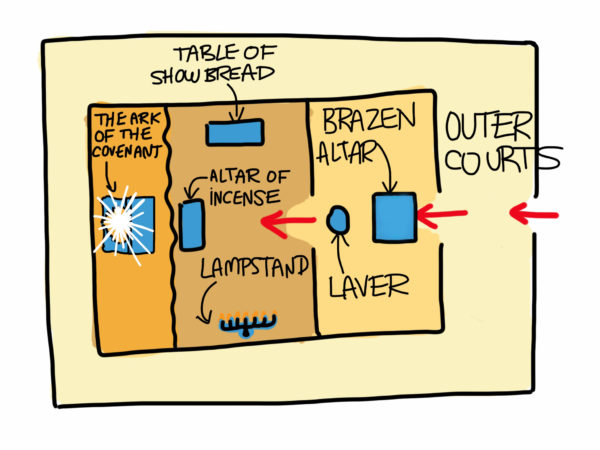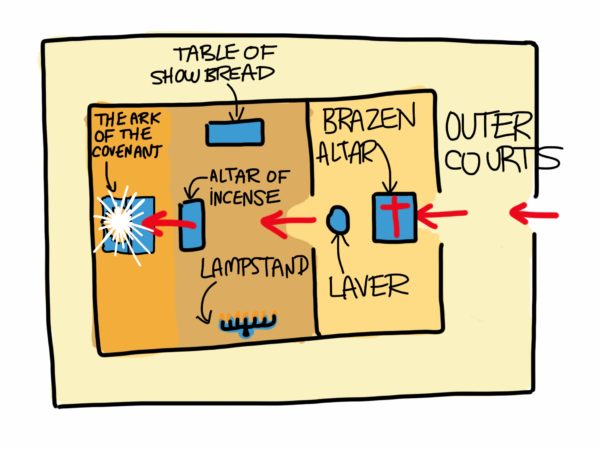In the Old Testament, the Israelites stuck to a very clear order of worship based on the Old Testament temple system. It looked like so:
The Old Testament Flow of Worship
Worshippers began with “Songs of Ascent” as they walked up the hill into Jerusalem. These songs can be found in Psalms 120-134, and were designed to help worshippers vent about what was going on in their lives while lifting their spiritual eyes to God.
When they entered the Temple Courts, their eyes had been lifted from their own circumstances to focus on God. At this point, they would “Enter his gates with thanksgiving, and his courts with praise” (Psalm 100:4).
Only priests and Levites could go further, into the sacrificial area where livestock were slaughtered as blood sacrifices for sin. A giant laver (sink) was also present with this giant altar, so the priests could wash up when they were done.
Having shed blood for sin, only priests could enter what was called the Holy Place. In this room stood three pieces of furniture. The seven-budded Lampstand (Menorah) was a lamp that never went out because it was continually fed oil and kept lit. It symbolized the continuous presence of God. And then there was the table with the showbread on it, symbolizing the promise of God’s loving provision. The third piece was the altar where the priests would burn incense to symbolize the prayers of the people. So the priests would pray at an altar, a symbol of submission. But they would pray with the promise of God’s presence and God’s provision all around them. So powerful!
And then… drum roll please… the High Priest would enter the Most Holy Place once a year, passing through a curtain into the room where only the Ark of the Covenant Stood, above which the manifest glory of God was hovering. Here there was nothing to do but be in his presence and worship.
The New Testament Flow of Worship
As Christians, we know Jesus fulfilled the Old Testament Temple system—but more, he transformed it. In Christ, we’re no longer jumping through worship hoops to appease God. We’re traveling a worshipful path designed to help us connect with God. To put it another way, the Old Testament flow was for God. The New Testament flow is for us. I’ll show you what I mean.
We begin our approach with scattered minds and hearts, moving through an “ascent” stage designed to help us vent about what was going on in our lives while lifting our spiritual eyes to God:
“God, it’s been a tough week. So hard. I’m exhausted. But I look to you.”
Then we enter “Enter his gates with thanksgiving, and his courts with praise” (Psalm 100:4). It might look like this:
“You are my life. You are what I need. Thank you for never giving up on me.”
As Christians we can walk right into the sacrificial area where only priests and Levites could formerly tread. But we don’t come with sacrifices. Here we celebrate what Jesus has done for us, his once-for-all sacrifice that makes us holy and washes away our guilt;
“Thank-you for your grace. I confess my sin to you, my attitude. Thank you for your forgiveness, for this new start.”
Because of Christ’s shed blood for sin, we enter the Holy Place to pray at the altar of submission. We lay ourselves at the feet of Jesus, flanked by the promise of God’s presence and God’s provision all around us:
“Father, I know you are always with me. That you have promised to provide for me. So I ask in the name of Jesus for…”
And then… are we done? No way.
We’ve laid out our hearts and distractions. Lifted our eyes to God. Thanked him for who he is and what he’s done. Laid out our requests before him. So now, with the curtain torn and out of the way, we step into the Most Holy Place—not once a year, but whenever we like. We are free to enjoy the manifest glory of God. And because we’ve moved through this order of worship, there is only one thing left to do: be in awe and worship our awesome God.
“Whoah.”
We have access to God anywhere, any time. There are no sacrifices to make, no sins to pay for, no hoops God expects us to jump through. But we really do benefit from walking this path for our own sake. It helps us approach God in such a way that we’re freed from all our burdens. We experience who he is and become more of who we’re created to be.


